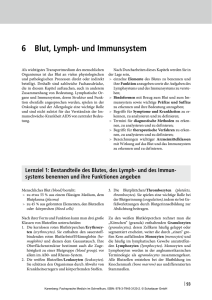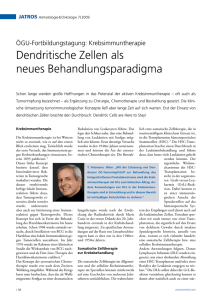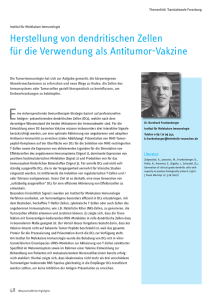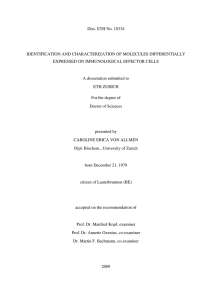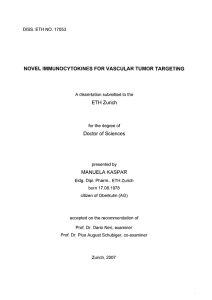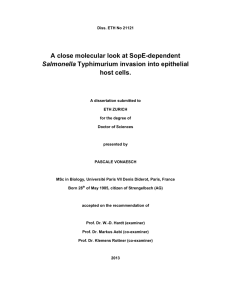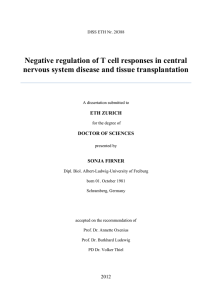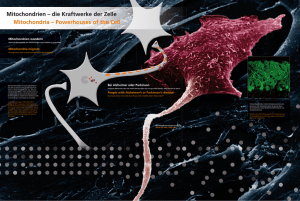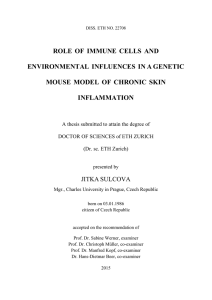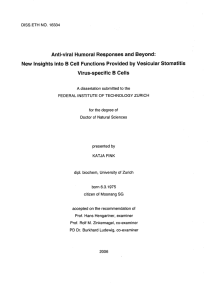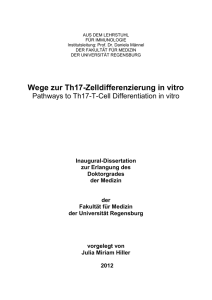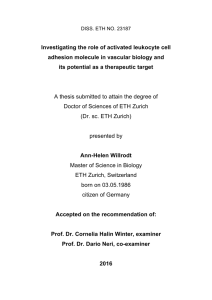DISS corrected 011713 - ETH E
Werbung
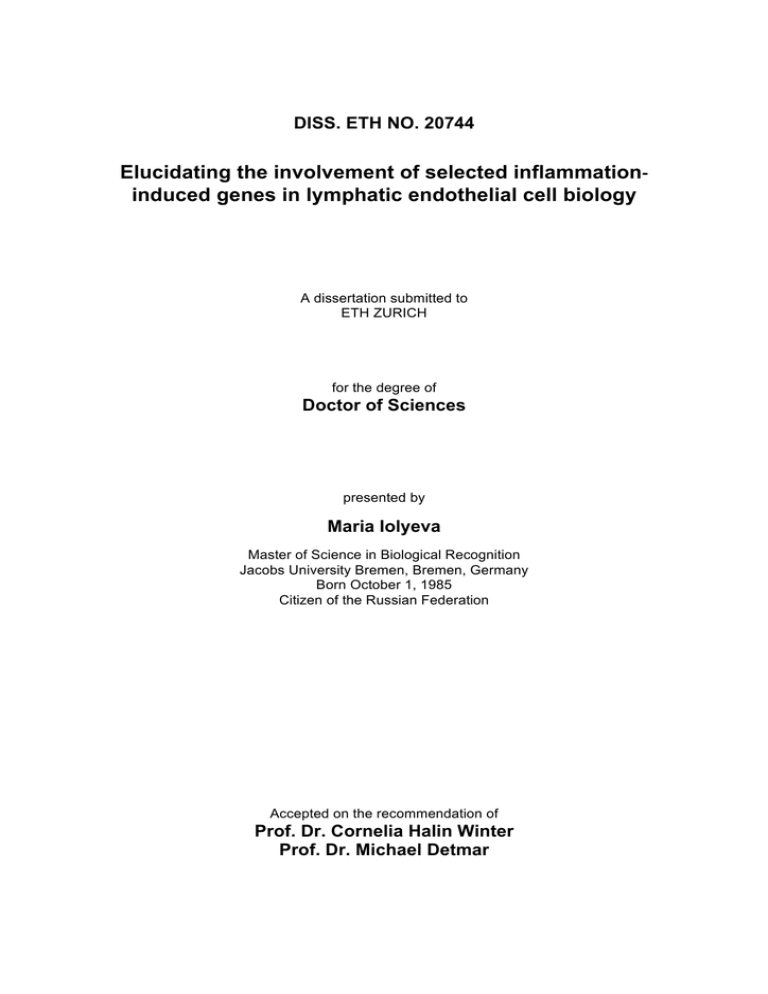
DISS. ETH NO. 20744 Elucidating the involvement of selected inflammation-­‐ induced genes in lymphatic endothelial cell biology A dissertation submitted to ETH ZURICH for the degree of Doctor of Sciences presented by Maria Iolyeva Master of Science in Biological Recognition Jacobs University Bremen, Bremen, Germany Born October 1, 1985 Citizen of the Russian Federation Accepted on the recommendation of Prof. Dr. Cornelia Halin Winter Prof. Dr. Michael Detmar 1.1 Summary The lymphatic vascular system in the human body regulates tissue fluid homeostasis, fat uptake and immune surveillance. In adults, the growth of lymphatic vessels, namely lymphangiogenesis, occurs during pathologic conditions, such as in chronic inflammation and in tumor growth and metastasis. On the other hand, the lack of lymphatic vessels is incompatible with life and dysfunctional lymphatic vessels cause chronic edema and impaired immune responses. In our laboratory, we are elucidating the mechanisms involved in the cross-talk between the lymphatic vascular system and the immune system. Many elements of the response of lymphatic vessels to inflammation are presently not well understood. Recently, a comprehensive microarray-based gene expression analysis of lymphatic endothelial cells (LECs), isolated from inflamed and resting murine skin, was performed by our group. This analysis revealed that several cytokine receptors and cell adhesion molecules are expressed and upregulated during the inflammatory response in LECs. In this thesis, selected candidate genes that were identified in this study were analyzed for their involvement in LEC biology and lymphatic vessel (LV) function. In a first project, the role of the activated leukocyte cell adhesion molecule (ALCAM CD166) was analyzed. ALCAM is an adhesion molecule of the immunoglobulin superfamily, which reportedly is expressed on leukocytes, blood vascular endothelial cells (BECs), as well as on cells of the central nervous system. ALCAM engages in homophilic interactions, as well as in heterophilic interactions with CD6 and L1CAM. In this study, we found ALCAM to be expressed in lymphatic and blood vascular endothelial cells. Functional in vitro experiments revealed that ALCAM mediates adhesive interactions, migration and formation of tube-like structures in LECs, suggesting a role for ALCAM in LV stability and in lymphangiogenesis. In agreement with these findings, experiments performed in ALCAM-/- mice detected reduced LEC numbers in various tissues and defects in the formation of an organized LV network. Furthermore, we observed that ALCAM supported interactions between LECs and dendritic cells (DCs) in vivo and in vitro. DCs are antigen-presenting cells and are crucial for the initiation of the adaptive immune response. Blockade of ALCAM reduced adhesion of DCs to lymphatic endothelium. In line with this observation, DC migration from lung to draining lymph nodes was compromised in ALCAM-/- mice. Collectively, our data reveal a novel role for ALCAM in stabilizing LEC-LEC interactions and in the organization and function of the LV network. 3 In a second project, we investigated the role of the cytokine interleukin-7 (IL-7) in lymphangiogenesis and LV function. IL-7 is mainly produced by stromal cells, including keratinocytes and fibroblastic reticular cells (FRCs), but also by lymphoid tissue inducer cells (LTi cells) and DCs. IL-7 is important for the maturation of T and B lymphocytes and lymphoid tissue development. We identified dermal LECs as major producers of IL-7 and detected IL-7 protein in human afferent, skin-draining lymph. Additionally, we observed that LECs from various tissues expressed the IL-7 receptor chains IL-7Rα and CD132. Stimulation of cultured LECs with recombinant IL-7 induced a pronounced upregulation of the LEC-specific transcription factor Prox1 and enhanced LEC in vitro function. In vivo, recombinant IL-7 induced significant lymphangiogenesis in the cornea of wild-type (WT) mice. Furthermore, transgenic overexpression of IL-7 led to the expansion of the dermal LV network and enhanced its drainage function. By contrast, LVs in the skin of IL-7Rα-/- mice displayed a reduced vessel diameter, abnormal lymphatic network organization and reduced drainage function. Finally, treatment with recombinant IL-7 significantly enhanced lymphatic drainage in the skin of WT mice. Overall, our data reveal an unexpected novel role for IL-7 in supporting the function of LVs. In a third project, the role of thymic stromal lymphopoietin (TSLP), which is another cytokine signaling via IL-7Rα chain, in lymphangiogenesis was studied. TSLP is expressed by epithelial cells and different types of stromal cells. Physiologically, TSLP is important for activation of B cells and DCs as well as for Th2-polarization of immune responses. We detected expression of the IL-7Rα and TSLPR on cultured LECs and BECs. Stimulation with TSLP induced distinct cellular processes in LECs, such as proliferation, migration, tube formation and adhesion to components of the extracellular matrix. Furthermore, the role of TSLP signaling in BECs was analyzed. Our experiments revealed that TSLP induced proliferation, as well as adhesion of BECs to collagen and fibronectin. These data demonstrate for the first time that TSLPR is expressed in endothelial cells and that TSLP signaling is functionally important for endothelial cell biology. Overall, our findings provide new insights into LEC biology. Specifically, the candidate genes studied here were shown to be important for lymphangiogenesis, lymphatic network organization and LV function. The knowledge gained from this work may be useful for designing new therapeutic approaches for the treatment of lymphedema or tumor-associated lymph- and angiogenesis. 4 1.2 Zusammenfassung Das Lymphsystem des Menschen reguliert die Flüssigkeitshomöostase im Gewebe, die Fettstoffaufnahme und die Immunabwehr. Das Wachstum von Lymphgefässen, die so genannte pathologischen Lymphangiogenese, Bedingungen statt, wie findet zum bei Erwachsenen Beispiel während nur unter chronischen Entzündungen und bei Tumorwachstum. Die Funktionsstörungen der Lymphgefässe führen zur Beeinträchtigung von Patienten und äußern sich in der Bildung chronischer Ödeme und einer eingeschränkten Immunantwort. Unser Labor erforscht das Zusammenspiel des lymphatischen Systems mit dem Immunsystem. Insbesondere interessiert uns, wie Entzündungsreaktionen auf das Lymphgefässsystem einwirken. In unserer Arbeitsgruppe wurde kürzlich eine umfassende transkriptionelle Analyse von lymphatischen Endothelzellen (LECs), welche aus unbehandelter oder entzündeter Maushaut isoliert wurden, durchgeführt. Basierend auf dem daraus resultierenden Expressionsprofil konnte gezeigt werden, dass verschiedene Rezeptoren von Zytokinen und Adhäsionsmolekülen auf LECs exprimiert sind und während der Entzündung hochreguliert werden. In dieser Doktorarbeit wurden verschiedene Kandidaten Gene, welche aus besagter Studie hervorgingen, auf ihre Funktion in LECs bzw. Lymphgefässen untersucht. Im ersten Projekt Zelladhäsionsmoleküls Adhäsionsmolekül wurde die Funktion - CD166) (ALCAM der Blutgefäss-Endothelzellen des analysiert. Immunglobulin-Superfamilie, (BECs), und auch aktivierten auf das Leukozyten ALCAM auf Zellen ist ein Immunzellen, des zentralen Nervensystems exprimiert wird. ALCAM kann homophile Interaktionen eingehen, sowie heterophile mit CD6 und L1CAM. In unserer Studie konnten wir nachweisen, dass ALCAM auf Endothelzellen der Lymph- und Blutgefässe exprimiert wird. In funktionalen Tests mit kultivierten lymphatischen Endothelzellen konnte gezeigt werden, dass ALCAM an zellulären Prozessen wie der Adhäsion, der Migration und der Bildung von gefässartigen Strukturen beteiligt ist. Diese Ergebnisse deuten darauf hin, dass ALCAM eine Rolle in der Stabilität von Lymphgefässen und in der Lymphangiogenese spielt. Die Charakterisierung der Lymphgefässe von ALCAM-/Mäusen ergab, dass die Anzahl an LECs in verschiedenen Geweben reduziert ist und dass das Lymphgefässsystem im Vergleich zu Wildtyp-Mäusen (WT) Defekte aufweist. Außerdem konnten wir zeigen, dass ALCAM eine Rolle bei der Interaktion von LECs mit dendritischen Zellen (DCs) spielt. DCs sind Antigen-präsentierende Zellen, welche unerlässlich für die Induktion einer adaptiven Immunantwort sind. Die 5 Blockierung von ALCAM in vitro führte zu einer verminderten Adhäsion der DCs an LECs. Des weiteren beobachteten wir, dass in ALCAM-/- Mäusen die Migration von DCs aus der Lunge zu den drainierenden Lymphknoten reduziert ist. Insgesamt zeigen unsere Daten eine neue Rolle für ALCAM in der Stabilisierung von LEC-LEC Interaktionen und in der Organisation und Funktion des LV-Netzes. In einem zweiten Projekt wurde die Funktion des Zytokins Interleukin-7 (IL-7) in der Lymphangiogenese untersucht. IL-7 wird hauptsächlich von Stromazellen, wie Keratinozyten und fibroblastischen Retikulumzellen (FRCs), sowie von Lymphgewebe Induktoren Zellen (LTi) und DCs produziert. Ebenso ist IL-7 für die Differenzierung von T- und B-Lymphozyten und für die Entwicklung des Lymphgewebes wichtig. Unsere Untersuchungen zeigten, dass auch dermale LECs wichtige Produzenten von IL-7 sind. Zudem entdeckten wir, dass LECs auch die zwei Ketten der IL-7 Rezeptors (IL-7Rα und CD132) exprimieren. Die Stimulation von kultivierten LECs mit rekombinantem IL-7 führte zu einer starken Induktion des LECspezifischen Transkriptionsfaktors Prox-1 und stimulierte die Aktivität von LECs in in vitro Assays. Die Behandlung von Mäusen mit rekombinantem IL-7 führte ebenfalls zu einer signifikanten Induktion der Lymphangiogenese in der Kornea. Die Untersuchung von IL-7 transgenen Mäusen zeigte, dass Überexpression von IL-7 zur Expansion des dermalen Lymphgefässnetzes führt und dies eine verstarkte Drainage Funktion zur Folge hat. Im Gegensatz dazu wiesen Lymphgefässe in der Haut von IL-7Rα-/- Mäusen einen reduzierten Gefässdurchmesser, eine abnormale lymphatische Netzorganisation und eine verminderte Drainage Funktion auf. Des weiteren konnten wir zeigen, dass die chronische Behandlung mit rekombinantem IL7 die Lymphdrainage in der Haut von Mäusen steigerte. Zusammenfassend machen unsere Daten deutlich, dass IL-7 eine wichtige Rolle für die Funktionalität von Lymphgefässen spielt. In einem dritten Projekt wurde das Zytokin Thymus stromales Lymphopoietin (TSLP), welches ebenfalls via IL-7Rα Signale in das Innere der Zelle vermittelt, auf seine Funktion in der Lymphangiogenese untersucht. TSLP wird von Fibroblasten, Epithelzellen und anderen Stromazellen exprimiert und ist in der Aktivierung von BZellen und DCs sowie in der Th2-Polarisierung der Immunantwort involviert. In unserer Studie konnten wir die Expression des IL-7Rα und des TSLPR auf kultivierten LECs und BECs nachweisen. Die Stimulation mit TSLP führte zu einer Induktion von verschiedenen zellulären Prozessen in LECs, z.B. zur Proliferation, Migration, zur Bildung von gefässartigen Strukturen und zur Adhäsion an Komponenten der extrazellulären Matrix. Zudem wurde die Rolle der TSLP6 vermittelten Signalkaskade in BECs untersucht. Unsere Experimente zeigten, dass TSLP die Proliferation sowie die Adhäsion von BECs an Kollagen und Fibronektin induziert. Diese Daten weisen somit zum ersten Mal die Expression von TSLPR auf Endothelzellen nach und deuten darauf hin, dass TSLP eine wichtige Rolle in der Endothelzellbiologie spielt. Zusammenfassend konnten durch diese Doktorarbeit neue Einblicke in die Biologie und die Entzündungsreaktion vom LECs gewonnen werden. Die Arbeit zeigt, dass die untersuchten Kandidatengene wichtige Rollen in der Lymphangiogenese, der lymphatischen Netzorganisation und in der Funktion von Lymphgefässe spielen. Die Erkenntnisse dieser Arbeit stellen wichtige Informationen dar, welche für die Entwicklung neuer therapeutischer Ansätze für die Behandlung von Lymphödemen oder Tumor-assoziierter Lymphangiogenes und Angiogenese nützlich sein können. 7
